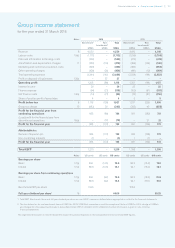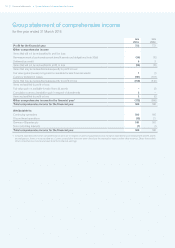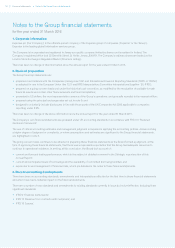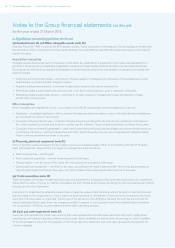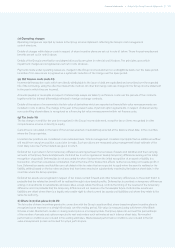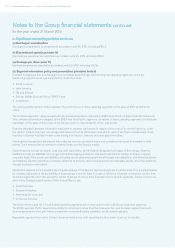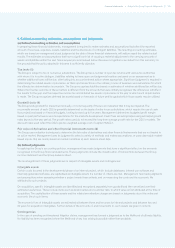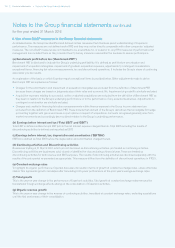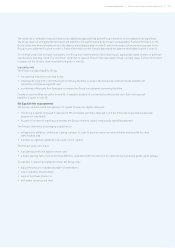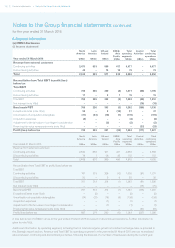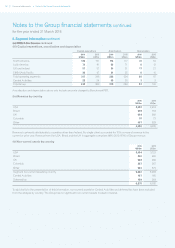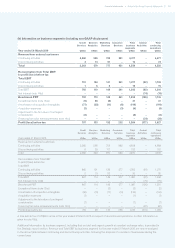Experian 2016 Annual Report Download - page 125
Download and view the complete annual report
Please find page 125 of the 2016 Experian annual report below. You can navigate through the pages in the report by either clicking on the pages listed below, or by using the keyword search tool below to find specific information within the annual report.
123•Notes to the Group nancial statementsFinancial statements
(o) Operating charges
Operating charges are reported by nature in the Group income statement, reflecting the Group’s cost-management
control structure.
Details of charges within labour costs in respect of share incentive plans are set out in note (r) below. Those for post-employment
benefits are set out in note (l) above.
Details of the Group’s amortisation and depreciation policy are given in notes (e) and (f) above. The principles upon which
impairment charges are recognised are set out in note (d) above.
Payments made under operating leases are charged in the Group income statement on a straight-line basis over the lease period.
Incentives from lessors are recognised as a systematic reduction of the charge over the lease period.
(p) Net finance costs (note 14)
Incremental transaction costs which are directly attributable to the issue of debt are capitalised and amortised over the expected
life of the borrowing, using the effective interest rate method. All other borrowing costs are charged in the Group income statement
in the year in which they are incurred.
Amounts payable or receivable in respect of interest rate swaps are taken to net finance costs over the periods of the contracts,
together with the interest differentials reflected in foreign exchange contracts.
Details of the nature of movements in the fair value of derivatives which are reported as financial fair value remeasurements are
included in note (i) above. The change in the year in the present value of put/call option agreements, in respect of shares held by
non-controlling shareholders, is recognised as a financing fair value remeasurement within net finance costs.
(q) Tax (note 15)
The tax charge or credit for the year is recognised in the Group income statement, except for tax on items recognised in other
comprehensive income or directly in equity.
Current tax is calculated on the basis of the tax laws enacted or substantively enacted at the balance sheet date, in the countries
where the Group operates.
Uncertain tax positions are considered on an individual basis. Where management considers it probable that an additional outflow
will result from any given position, a provision is made. Such provisions are measured using management’s best estimate of the
most likely outcome. Further details are given in note 5.
Deferred tax is provided in full on temporary differences arising between the tax bases of assets and liabilities and their carrying
amounts in the Group financial statements. Deferred tax is not recognised on taxable temporary differences arising on the initial
recognition of goodwill. Deferred tax is not accounted for when it arises from the initial recognition of an asset or liability in a
transaction, other than a business combination, that at the time of the transaction affects neither accounting nor taxable profit or
loss. Deferred tax assets and liabilities are calculated at the tax rates that are expected to apply when the asset is realised or the
liability settled, based on the tax rates and laws that have been enacted or substantively enacted by the balance sheet date, in the
countries where the Group operates.
Deferred tax assets are recognised in respect of tax losses carried forward and other temporary differences, to the extent that it is
probable that the related tax benet will be realised through future taxable prots. Deferred tax is provided on temporary differences
arising on investments in subsidiaries and associates, except where the Group controls the timing of the reversal of the temporary
difference and it is probable that the temporary difference will not reverse in the foreseeable future. Deferred tax assets and
liabilities are offset where there is a legally enforceable right to offset current tax assets and liabilities and where they relate to the
same tax authority.
(r) Share incentive plans (note 30)
The fair value of share incentives granted in connection with the Group’s equity-settled, share-based employee incentive plans is
recognised as an expense on a straight-line basis over the vesting period. Fair value is measured using whichever of the Black-
Scholes model, Monte Carlo model or closing market price is most appropriate. The Group takes into account the best estimate
of the number of awards and options expected to vest and revises such estimates at each balance sheet date. Non-market
performance conditions are included in the vesting estimates. Market-based performance conditions are included in the fair
value measurement but are not revised for actual performance.


